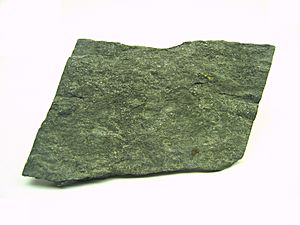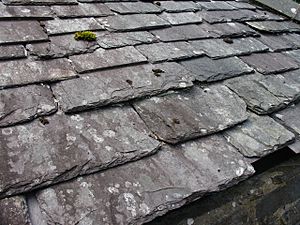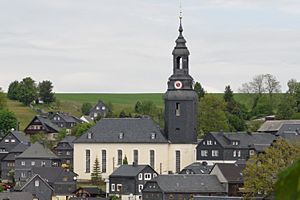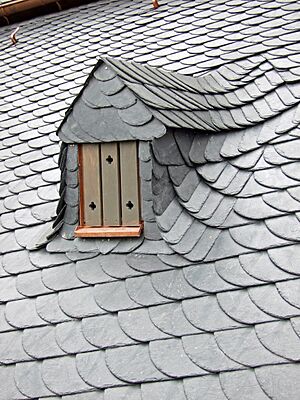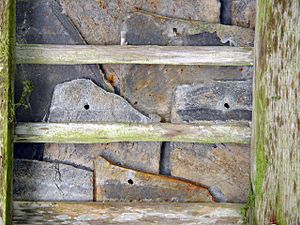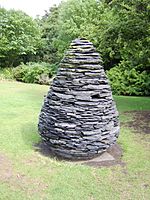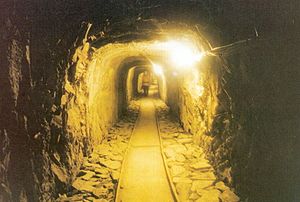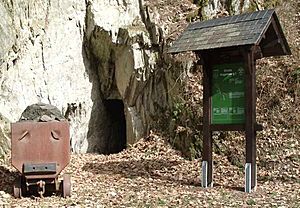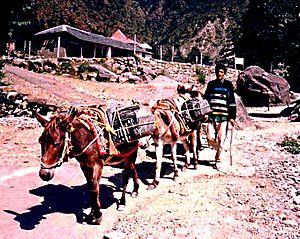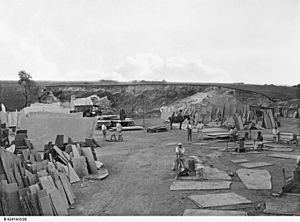Slate facts for kids
| Metamorphic rock | |
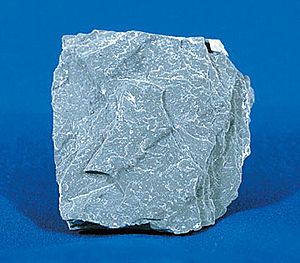
Slate
|
|
| Composition | |
|---|---|
| Primary | quartz, muscovite/illite |
| Secondary | biotite, chlorite, hematite, pyrite Specific gravity: 2.7 – 2.8 |
Slate is a special type of rock called a metamorphic rock. This means it started as one kind of rock and changed into another due to heat and pressure deep inside the Earth. Slate usually forms from shale, which is a sedimentary rock made of clay or volcanic ash.
Slate is known for being very fine-grained, meaning its particles are tiny. It also has a unique feature called "foliation." This means the minerals inside the rock are lined up in flat layers, almost like pages in a book. This layering is why slate can be split into thin, flat sheets. These sheets have been used for many things, like roofs and floor tiles, for a very long time.
Slate comes in many colors, but it's often grey. You might also see it in purple, green, or even blue colors, depending on where it came from. It's important not to confuse slate with shale, which is the rock it often forms from, or schist, which is another type of metamorphic rock. The word "slate" can also refer to objects made from this rock, like a roofing tile or an old-fashioned writing board.
Contents
What is Slate Made Of?
Slate is mostly made of two common minerals: quartz and muscovite (or a similar mineral called illite). It can also contain smaller amounts of other minerals like biotite, chlorite, hematite, and pyrite. Sometimes, you might find tiny bits of apatite, graphite, kaolinite, magnetite, tourmaline, or zircon.
In some purple slates, you might see light green spots. These spots form around tiny pieces of iron. If the rock is squeezed later, these spots can get stretched into oval shapes.
How is Slate Used?
Slate is a very useful rock, especially in building and construction. Its unique properties make it great for many purposes.
Slate in Buildings
One of the most common uses for slate is as roof shingles, also called roofing slates. Slate is perfect for roofs because it barely absorbs any water (less than 0.4%). This makes it naturally waterproof. It's also very durable and can last for hundreds of years with little care. Slate roofs are also resistant to frost damage and fire.
Slate can be split into thin sheets because it has two natural lines where it breaks easily. This makes it easy to work with. In the late 1800s and early 1900s, slate became very popular for roofing in Europe, partly because new transportation systems made it easier to move the heavy stone.
Roofing slates are usually attached with nails or hooks. In the UK, they are often nailed onto wooden supports. Copper nails were traditionally used, but modern nails are made of special alloys or stainless steel. A properly installed slate roof can last 80 to 100 years.
Some builders in Europe prefer using hooks to fix slate tiles. They say hooks mean:
- Fewer weak spots on the tile, as no holes are drilled.
- It's easier to create complex roof shapes.
- Hooks offer better resistance to strong winds because the bottom edge of the slate is held down.
However, the metal hooks are visible, so they might not be used on very old or historic buildings.
Slate tiles are also used for floors, stairs, walkways, and even covering walls, both inside and outside buildings. They are set in mortar and the gaps are filled with grout. Sometimes, sealants are used to make the tiles last longer, look better, and resist stains. Slate floors can be slippery when wet, so they are often used indoors or in covered outdoor areas.
In areas where slate is common, like parts of Wales, you can find many buildings made entirely of slate. Small pieces of slate are even used to level wooden floor beams. People also use slate to build walls and fences, sometimes mixing it with other types of stone. In modern homes, small pieces of slate are often used as coasters for drinks.
Other Uses for Slate
Slate is a good electrical insulator, meaning it doesn't conduct electricity well. It's also fireproof. Because of these qualities, it was used in early 1900s electric switchboards and controls for large electric motors. Fine slate can also be used as a whetstone to sharpen knives.
Because slate is stable in heat and doesn't react with many chemicals, it has been used for laboratory countertops and billiard table tops. In schools during the 18th and 19th centuries, slate was widely used for blackboards and small individual writing slates, where students would write with chalk or slate pencils.
High-quality slate is sometimes used for tombstones and special memorial plaques. The ancient Maya people even used slate to create large carved stone monuments called stelae.
In Japan, slate was traditionally the material of choice for the black stones used in the game of Go. Today, these are considered a luxury item.
- Other uses
Where is Slate Found?
Slate in Europe
Today, most slate in Europe comes from Spain. Spain is the world's largest producer and exporter of natural slate. About 90% of the natural slate used for roofing in Europe comes from Spain.
Other places in Europe that produce slate include Wales (which has a National Slate Museum), Cornwall in England, and parts of Cumbria. There are also slate quarries in parts of France, Belgium, northern Italy, and Portugal. Germany has slate regions near the Moselle River and in other areas. Some slate from Wales and Cumbria is colorful, like purple or green.
Slate in the Americas
Brazil is the world's second-biggest producer of slate. Most of Brazil's slate comes from the area around Papagaios in Minas Gerais.
Slate is also found in North America. There are deposits on the east coast of Newfoundland in Canada. In the United States, slate is mined in Eastern Pennsylvania, Buckingham County, Virginia, and the Slate Valley region of Vermont and New York. Colorful slate is found in Granville, New York. Pennsylvania slate is even used to make special calls for hunting wild turkeys.
A large slate mining operation used to exist in Monson, Maine. The slate there is usually dark purple to black. Many buildings in Monson still have slate roofs. The roof of St. Patrick's Cathedral, New York and the headstone of John F. Kennedy were made from Monson slate.
In the Arctic, slate was used by the Inuit people to make blades for their traditional knives called ulus.
Slate in Asia
China has huge amounts of slate. In recent years, China has increased its export of both finished and unfinished slate. Chinese slate comes in many different colors.
Slate in Australia
Slate deposits are found all over Australia. Large amounts are quarried in the Adelaide Hills and the Mid North regions of South Australia.
Fossils in Slate
Because slate forms under relatively low heat and pressure compared to some other metamorphic rocks, it's sometimes possible to find fossils within it. Even tiny, delicate remains of ancient organisms can be preserved in slate.
Images for kids
See also
 In Spanish: Pizarra (roca) para niños
In Spanish: Pizarra (roca) para niños


